Use of Learning Toolbox by Bau-ABC Trainers and Apprentices
Main impacts
The Learning Toolbox was developed as an integrative toolset (mobile app container and toolkit) to support learning in the context of work. It was piloted firstly in the North German training centre Bau-ABC Rostrup to support apprentice training in the construction sector. The piloting was based on stacks created by Bau-ABC trainers for short training projects in their trades (carpentry, bricklaying, well-building, metalworking, pipeline-building). The main impacts of the pilots were the following:
- The trainers could shape their training project in a more flexible way. Some trainers developed joint projects for neighbouring trades (to highlight working interfaces). Some developed stacks with common patterns for parallel trades.
- The trainers could make more prominent use of trade-specific online resources (e.g. their own trade-specific blogs).
- The trainers could set their own accents for promoting self-organised learning among the apprentices. Some trainers emphasised problem-solving with a wide range of web resources to be searched. Others emphasised interest- and achievement-based expansion of resources that were made available in the course of learning process.
A more detailed picture of the pedagogic accents in the apprentice training is given in the Scenario document “Learning Toolbox (LTB) as Support for Action-Oriented Learning in the Apprentice Training of Bau-ABC - Instances of Change”.
The situation before Layers
During the first year the Learning Layers project team in ITB started with series of interviews with trainers of Bau-ABC Rostrup (later referred to as ‘Bau-ABC’) and with representatives of partner companies. With these interviews the ITB team got an overview on the use of Internet and web tools in several trades. Based on these results the ITB team continued its work with Bau-ABC trainers and apprentices.In the next phase the ITB team carried out user survey among Bau-ABC apprentices to get a picture of their use of new media, apps and tools - both in the context of learning and in their free time.
At this phase the Bau-ABC trainers were concerned of the quality apps and tools, many of them being developed for layman users and not for construction professionals. Also, not many apps were designed to support learning in the the context of work.
The representatives of partner companies reported on earlier variants of ‘new technologies’ that were not well developed for their working contexts and did not contribute to productivity as expected. Some of them had technical problems or were too complicated (hard to navigate) or were not compatible with other digital tools.
The apprentices were mostly unaware of apps and tools designed for their trades. In the survey (2014) of the 581 respondents, a high percentage of 86,7% indicated that they use a smartphone. The great majority of users (78,3%) are connected to the internet via their private smartphones. Despite this, the use of mobile devices is not encouraged by employers: only 1,9% of employers provide access to the internet and only 27% of employers allow the use of smartphones at the workplace. Yet, the respondents indicated that smartphones are used for acquiring work-related knowledge, through personal communication or from the internet. These activities are to a large extent carried out in the apprentices’ own time. 20% of the apprentices use their smartphones to make work-related photos and videos for documenting their practice.
Also, in Bau-ABC the use of mobile phones during the training was prohibited. Yet, during the pilot activities the use of mobile devices was allowed.
What Layers did
Highlights
In the earlier phases of the co-design process the project teams had reworked the initial design idea (digitisation of training and learning materials) into a new one.
-
The key idea of the Learning Toolbox (LTB) was to provide an integrative digital toolset that makes it possible to access web resources and relevant mobile apps, distribute trade-specific training materials and manage real-time communication.
-
In the actual implementation several Bau-ABC Rostrup trainers developed LTB stacks to support their apprentices in executing their projects during their stay in Bau-ABC.
-
The trainers used the functionality of the Learning Toolbox to follow somewhat different approaches in making learning resources available during the training process.
-
Altogether the use of Learning Toolbox enriched the training and learning processes and empowered the apprentices as self-organised learners.
Description
The Learning Layers’ pilot activities in Bau-ABC Rostrup started with a preliminary design idea that envisaged digitisation of the Bau-ABC White Folder (collector of paper-based instructions, worksheets and reporting documents used in the apprentice training). Gradually the co-design process transformed into development of an integrative toolset “Learning Toolbox” to be used via mobile devices for learning, knowledge sharing and reporting. The process dynamic can be presented as a gradual shift from a preparatory phase (interactive co-design workshops), transitional phase (software development parallel to training activities) and implementation phase (participative deployment and monitoring activities).
In the preparatory phase the co-design process with Bau-ABC Rostrup trainers went through several iterative cycles (including several mapping, storyboarding and design-oriented workshops). As a result of these processes the initial design idea was reworked into the concept of an integrative toolset, the Learning Toolbox (LTB) in Spring 2014. At that point Bau-ABC Rostrup trainers and apprentices participated in workshops with a mock-up version. At this stage preliminary thoughts of tile structures and on desired functionality were presented with visualisations. Also, Bau-ABC Rostrup trainers prepared videos with apprentices to demonstrate possible uses of LTB in training contexts and in construction work.
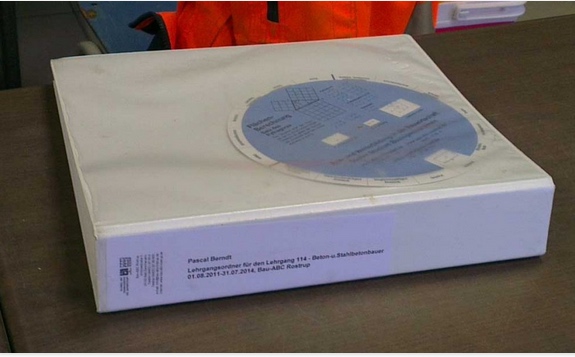
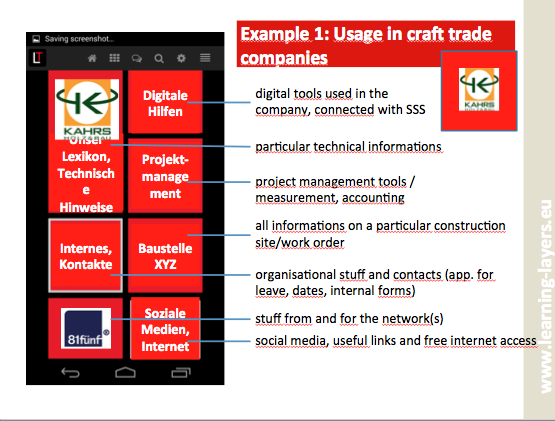
Figures 1 and 2: From digitisation of the White Folder to shaping of Learning Toolbox
In the transitional phase the co-design activities paved the way for software development. At this stage the LTB developer team worked with software solutions for LTB - in particular to integrate LTB with other Learning Layers tools. During this phase the research partners from Institut Technik & Bildung (ITB) and Pontydysgu organised with Bau-ABC two cycles of training interventions (see Multimedia Training for and with Bau-ABC trainers). In summer 2015 and in the autumn several Bau-ABC trainers were engaged as testers in preparing preliminary stacks and tiles for testing the Learning Toolbox. Altogether, this phase was characterised by raised awareness, how to work with digital media and web tools and with improved readiness to make use of LTB. And this was no longer a matter of individual learning of few individuals but instead a phase of emerging awareness to prepare the whole organisation for using new digital tools.
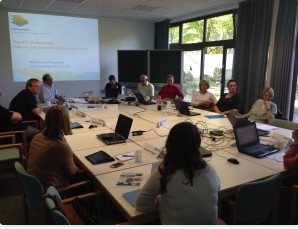
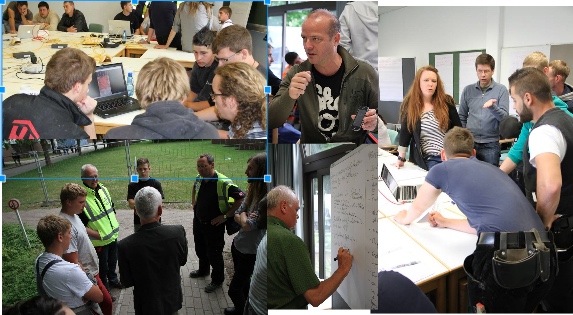
Figures 3 and 4: Training on the uses of Learning Toolbox with trainers and apprentices
In the implementation phase the research partners and LTB developers organised workshops for the pioneering Bau-ABC Rostrup trainers who were the first ones to introduce LTB in their training. They received a brief tutoring and then discussed their own ideas, how to shape their own LTB stacks (see Learning Toolbox) for the forthcoming apprentices’ projects that were scheduled for the week to introduce the LTB in their trades. During the next few weeks the trainers developed their own stacks further - to be used in the actual implementation starting in March 2016.
Already at this stage the trainers chose different exemplary projects for introducing the LTB to their apprentices. The project of well-builders (Brunnenbauer) was an ‘ordinary’ training project with one week’s duration. In the case of carpenters and bricklayers (Zimmerer und Maurer) the pilot case was a joint project that linked to each other training periods in both trades. During the introductory event - the LTB Kick-off Workshop - the Bau-ABC Rostrup trainers themselves introduced the LTB as a new toolset to be used from now on in the apprentices’ projects. The role of visiting Learning Layers partners was to support installation and registration (and real-time debugging).
The situation after Layers
Highlights
After introducing the LTB in their own trades some of the trainers served as peer tutors and mentors in promoting the use of the toolset in the neighbouring trades.
-
In some cases (e.g. the cooperation of carpenters and bricklayers) this was based on a joint training project that involved both trades.
-
In other cases this was based on the rotation of apprentices from one trade to another. In this way the apprentices could gather experiences in using LTB in different trades.
-
Together with the training activities (in particular the Theme Room training) the piloting with LTB has paved the way for new policies on the use of mobile devices in training.
Description
After the initial implementation measures (during the LTB Kick-off Workshop) some of the research partners of Learning Layers (ITB, TLU, UIBK) have made monitoring visits to support the pilot and to collect feedback. Below some examples on trainers’ measures to broaden the use of LTB in further trades and on expanding the use to other learning contexts.
-
During the annual training days for Bau-ABC Rostrup staff (in May 2016) trainer Markus Pape gave a presentation on LTB for all training staff of Bau-ABC Rostrup and parallel training centre ABZ Mellendorf.
-
Shortly afterwards the Bau-ABC Rostrup trainers who had first introduced LTB in their own trades started giving peer tutoring to other trades. For example, the pioneering group of well-builders was rotating to other trades and the trainers prepared them new stacks in the same style as they were used to work with.
-
In a similar way Bau-ABC Rostrup trainers have taken steps to introduce the use of LTB in the transversal learning area Health and Safety (Arbeitssicherheit und Gesundheitsschutz) by creating a prototype stack (to be complemented with domain-specific stacks).
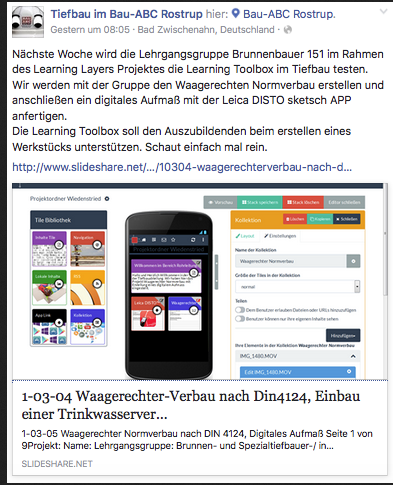
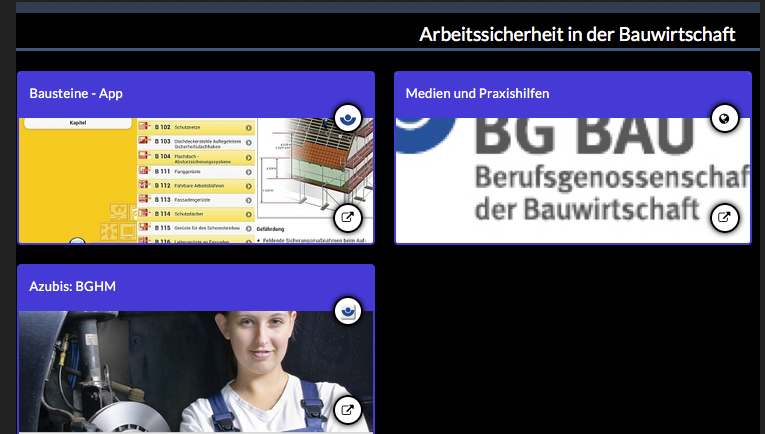
Figures 5 and 6: Promoting the use of Learning Toolbox via Facebook-group of Bau-ABC and draft stack for Health and Safety with links to reference materials of BG Bau
The monitoring visits of research partners in Bau-ABC Rostrup completed the following tasks:
-
In May the research partners (UIBK, ITB) collected feedback on the use of LTB from the pioneering trades.
-
In August and September the collection of feedback focused mainly on the use of LTB in different trades but also provided a picture on different patterns of supporting learning (see more detailed account in Learning Toolbox (LTB) as Support for Action-Oriented Learning in the Apprentice Training of Bau-ABC - Instances of Change).
Impact that Layers created
Changed learning practices
Some of the Bau-ABC trainers had made clear statements in the videos of 2014 that the use of LTB should support and self-organised learning in the context of vocational training. In the interviews they explained how the functionality of LTB and the design of their own stacks has helped them to empower the learners and stimulate more self-organised learning behavior across the training projects. Likewise, the apprentices confirmed in the focus group discussions that they had more challenges and opportunities to shape their learning processes themselves.
Enhanced digital competence
In this context it is worthwhile to note that the trainers had developed their project-related stacks for a specific variant of self-organised learning and respective use of learning resources:
-
The stack and tiles for well-builders (Brunnenbauer) were shaped as a comprehensive resource base for a problem-oriented learning strategy: to find a relevant set of necessary information for self-managed problem-solving (with awareness of one’s limits).
-
The stacks and tiles in some other trades were shaped as gradually enriched ‘resource layers’ to support an interest-based learning strategy: to encourage the learners to find their own solutions - and then to present other alternatives as points of comparison for sharing knowledge and experiences.
See more on these learning strategies in Learning Toolbox (LTB) as Support for Action-Oriented Learning in the Apprentice Training of Bau-ABC - Instances of Change
Improved the creation and use of learning resources
As has been indicated elsewhere (see Multimedia Training for and with Bau-ABC trainers), some of the Bau-ABC Rostrup trainers started to develop their own domain-specific blogs (Zimmererblog https://zimmererblog.wordpress.com/, Maurerblog https://maurerblog.wordpress.com/, Tiefbaublog https://tiefbaublog.wordpress.com/ and Brunnenbauerblog https://brunnenbauerblog.wordpress.com/) as means to deliver their training and learning materials. Also, as a result of the Theme Room training some of the trainers started using effectively GoConqr applications (Quizzes and Mindmaps) to stimulate learning. When the LTB was introduced, access to such resources became easier (via specific screens and tiles) and they were better integrated into the training projects.
Bridging learning contexts
Whilst most of the pilot activities have focused on trade-specific training activities within the training facilities of Bau-ABC, some steps have been taken to address more overarching or boundary-crossing learning needs. A specific context for such work is the shared learning area of ‘Health and safety’ (Arbeitssicherheit und Gesundheitsschutz). Here the initial emphasis is on providing user-friendly access to web-based information resources of competent bodies.
Improved take-up of innovation
In the beginning of the Theme Room training intervention the director of Bau-ABC indicated that Internet should be considered as the fourth learning venue in the dual system of apprentice training (alongside the company, the school and the training centre). In many respects Bau-ABC as an organisation has started a discussion, how to promote innovations in this respect and taken measures to improve its own infrastructure and practices.
Whilst Bau-ABC had previously been critical about uses of smartphones, the trainers are now being pushed to use them as support for training. Also, the use of mobile devices by apprentices - to access learning resources and to support their learning activities - is being valued. This is clearly a result of the training and pilot activities of the Learning Layers project.
However, most of construction companies still prohibit the use of mobile devices by apprentices or construction workers at the construction sites. Therefore, it was difficult for the apprentices to make use of Learning Toolbox in their companies. Yet, Bau-ABC has made its experiences to be able to promote the Learning Layers tools among the partner enterprises.
Glossary
Apprentice training in the German dual system: In Germany apprentice training is the dominant model of vocational education and training (VET). It is organised on the basis of the ‘dual system’ that refers to the co-responsibility of companies (responsible for workplace-based training) and vocational schools (responsible for school-based teaching and learning).
Intermediate training centres (Überbetriebliche Ausbildungsstätten): In the training for craft trades and in construction sector the workplace-based training is supported by a third learning venue - intermediate training centres. Bau-ABC Rostrup is a large intermediate training centre for the construction sector, located in Rostrup. It has workshops and outdoor learning areas with up-to-date equipment.
Training of apprentices in Bau-ABC Rostrup: The training of apprentices is delivered as training projects which normally last one week. The material for these projects is collected and organised in the Bau-ABC White Folder. It is the apprentice’s responsibility to archive them in the White Folder. The main aim of the White Folder is to support the continuity of the apprentice’s learning and professional growth across the completed training projects. The corollary aim of the White Folder is to provide a reference document for cooperation between the learning venues - construction company, vocational school and the intermediate training centre Bau-ABC.
Links to other sections
- Tools
- Impact cards
- Learning scenarios
- Research methodologies
Further Reading
Construction Evaluation Report
Articles on Learning Layers website
Learning Layers Theory Camp (2014) papers
Report on the User Survey in Bau-ABC (2014)
Logbooks of blogs on the development of the Learning Toolbox
References
- V. Banken, M. Geiger, R. Maier, M. Manhart, C. Sarigianni, S. Thalmann, and J. Thiele, “Report of Summative Evaluation in the Construction Pilots,” pp. under review, 2016 [Online]. Available at: Link
Contributing Authors
- Pekka Kämäräinen (ITB)
- Melanie Campbell (BAUABC)
- Ludger Deitmer (ITB)
- Lars Heinemann (ITB)
- Werner Müller (ITB)
- Graham Attwell (PONT)
- Dirk Stieglitz (PONT)
- Owen Gray (PONT)
- Gilbert Peffer (CIMNE)
- Raymond Elferink (RAYCOM)
- Lothar Schoka (BAUABC)
- Markus Pape (BAUABC)
- Kevin Kuck (BAUAUBC)
- Stefan Wiedenstried (BAUABC)
